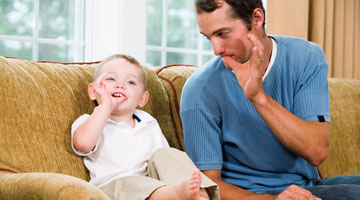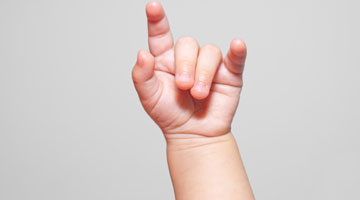Baby Sign Language
What is baby sign language?
Communication is the key to cognitive, social, emotional, and behavioral development in children. Before your baby develops the ability to communicate verbally, their primary way to communicate with you is crying. Baby Sign Language is a way of giving your infant or toddler the ability to express their emotions and needs via gestures. To understand the benefits of Baby Sign and begin learning how to incorporate sign into your baby’s life, Kids in the House has compiled advice from leading speech pathologists and baby sign language experts.
When to start teaching baby sign language?
Baby Sign Language instructor, Heather Ellington, believes it is never too late to teach your child to sign. “You can start signing any time. Sign language is a really good way to bridge the gap between spoken language and literacy development. So when you start reading books to your baby, you can start signing all of the different book signs like bear or helicopter or airplane,” says Ellington.
Some parents hesitate teaching their baby to sign because
... Read more
they are worried it could slow down speech development. You can rest easy knowing that research shows that teaching a child baby sign language will enhance verbal communication, not deter it. However, Ellington encourages parents with any concerns to speak with their pediatrician, speech language pathologist, or audiologist.
Parents with children with special needs should have a conversation with their pediatrician, speech language pathologist, and members of their Individualized Educational Plan before adding sign language to their routine.
“For some kids, it is a really good idea. For some, it is not,” Ellington explains, “So it is important that everyone is on board and that you look at the child’s functional communication needs and see if that is a good idea to add into your routine.”
Pros of teaching baby sign language
- Reduces tantrums
- Advances cognitive development
- Enhances vocabulary
- Improves parent-child communication
- Minimizes parents’ frustration in interpreting a pre-verbal child’s needs
Baby Sign Language Chart

Baby sign language is taught in tandem with verbal communication, so instead of replacing spoken language with sign, use both together when communicating with your baby. Begin by teaching 2 to 3 signs by signing the gesture as you say the word. Expand the vocabulary as you feel comfortable, adding signs gradually. Ellington suggests choosing words that relate to your family’s daily routine, including feeding time, bath time, or diaper changers.
The Basics of Teaching Signs
Baby sign language is taught in tandem with verbal communication, so instead of
replacing spoken language with sign, use both together when communicating with your baby. Begin by teaching 2 to 3 signs by signing the gesture as you say the word. Expand the vocabulary as you feel comfortable, adding signs gradually. Ellington suggests choosing words that relate to your family’s daily routine, including feeding time, bath time, or diaper changers.
“One of the signs that I like to teach – or I like to recommend to parents to teach their babies first – is a sign ‘more’. You take two closed hand shapes and bounce them together.’ Ellington’s other suggestions for your baby’s first signs are ‘milk’, ‘potty’, or ‘toilet’.
If your child is signing with you but using incorrect gestures, all you need to do is continue to model the right form of the sign.
“And it is okay to gently correct them or move their hands in a gentle way to make them use the right sign,” says Ellington.
When it is time to transition from using signs to communicate basic wants and needs, you can use sign language to facilitate phonic, literacy, and emotional development. Simply begin by introducing letters and sounds of letters.
“You can teach the sign “A”, “A” Sounds like “ah, “B”, “B” sounds like “buh” “, suggests Ellington.
You can also use baby sign to emphasize emotional connection and development by teaching your child to sign ‘I love you’ or to ask for a hug or kiss.
Make sure that all of your baby’s caregivers are on board with teaching your baby how to sign. It is important that all of the caregivers and family members are involved and know the signs that your baby is learning so that their signing communication is consistent.
“One of the ways that you can involve your caregivers in learning signs and make it fun for them is to play a game,” says Heather Ellington, “So you can play where's mommy, where's daddy, where one person would go out of the room and the care giver who is left, say it's mommy, would say where's daddy, where's daddy? Do you know the sign for daddy? Can you see daddy? Where's daddy? Then have daddy come out and say here I am, I'm daddy. And that's a fun way to get caregivers involved in signing.”
Determining when to stop signing with your child is a disputed issue. While some experts believe that sign communication can continue well into your child’s speech development, speech language pathologist, Barbara Schacter disagrees, “Signing is an okay prompt to use when your child is beginning to talk. As soon as they start to talk that prompt should be diminished because we are a speaking world, not a signing world. If your child is a hearing child, he will speak. It’s okay to frustrate your child a little bit and that you are not going to respond to his signs. He needs to use his words.”
Our Top Experts
Baby sign language can be a wonderful tool to empower your baby and help them communicate their wants and needs. For more information on baby sign language, check out what our top experts have to say on the best ways to help your child at kidsinthehouse.com.


















